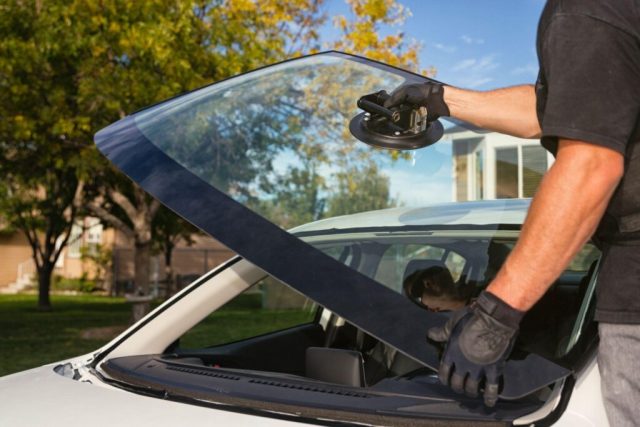How to Know Which You Need
This article may contain affiliate links.
Deciding between windshield repair and replacement hinges on the size, location and severity of the damage. Small chips or cracks (less than three inches) are typically repairable, while larger damage or cracks near the edges often require a full replacement. Windshield repair professionals emphasize that any damage in the driver’s line of sight should be assessed carefully, as it can compromise visibility and safety.
Table of Contents
Understanding Windshield Damage
When to Choose Windshield Repair
When to Opt for Windshield Replacement
Comparing Costs: Repair vs. Replacement
Imagine cruising down the highway when suddenly – a rock flies up and strikes your windshield. At first glance, it might seem harmless: just a tiny chip or hairline crack. But don’t let its size fool you. Over time, even minor damage can grow worse due to temperature fluctuations, vibrations or the constant pressure of driving. Left unchecked, it could jeopardize your safety—or even lead to a costly replacement.
How do you know whether to repair or replace your windshield? While some situations call for a quick fix, others demand a more comprehensive solution. In this guide, we’ll walk you through everything you need to consider, from understanding the type of damage to weighing the costs and benefits of each option. By the end, you’ll feel confident making the right choice for your vehicle – and your wallet.
For instance, if you’re dealing with what seems like minor damage, visiting a trusted auto glass service provider like Super Auto Glass can help you determine the best course of action. Let’s dive into the details and help you make an informed decision.
Understanding Windshield Damage
Before you can decide whether to repair or replace your windshield, it’s important to understand the nature of the damage. Not all chips and cracks are created equal, and their characteristics will guide your decision.
Types of Damage
Windshield damage comes in various forms, each with its own implications for repair or replacement:
Chips: Small, localized dents caused by debris like rocks or gravel. These often appear as round or star-shaped indentations and are typically easier to fix if addressed early.
Cracks: Thin lines that can spread across the glass. Cracks may be straight, jagged, or spiderweb-like, depending on the impact and stress on the windshield.
Bullseyes: Circular cracks with a clear point of impact, resembling a bullseye target. These are common from direct hits by small objects.
Star Breaks: Multiple cracks radiating outward from a single point, creating a star-like pattern. These can worsen quickly if not repaired promptly.
Even minor damage, like a tiny chip, can grow into a larger issue over time. This is why understanding the type of damage is crucial before making any decisions.
Factors That Influence Your Decision
Several factors determine whether your windshield can be repaired or needs replacement:
Size of the Damage: Small chips (less than one inch) and short cracks (under three inches) are usually repairable. Larger damage, however, often requires a full replacement.
Location: Damage near the edges of the windshield compromises its structural integrity and often necessitates replacement. Cracks directly in the driver’s line of sight should also be taken seriously, as they can distort visibility and pose a safety risk.
Depth: Surface-level damage is easier to fix, but deeper cracks that penetrate multiple layers of glass are harder to repair effectively.
When to Choose Windshield Repair
In many cases, repairing your windshield is the most practical solution. It’s quicker, more affordable and less invasive than a full replacement. Here’s when opting for a repair makes the most sense.
Benefits of Repairing Your Windshield
Repairing your windshield offers several advantages that make it an attractive option for minor damage:
Cost-Effective: Repairs are significantly cheaper, often costing between $50 and $150, depending on the severity and location of the damage.
Time-Saving: Most repairs can be completed in under an hour, getting you back on the road with minimal disruption to your day.
Environmentally Friendly: By preserving the original glass, you reduce waste and minimize the environmental impact of manufacturing and disposing of new windshields.
Common Scenarios for Repairs
Here are some situations where a repair is likely sufficient:
Small Chips: A chip no larger than a quarter (about one inch in diameter) is typically a good candidate for repair.
Short Cracks: Cracks shorter than three inches that haven’t spread across the windshield can often be fixed without issue.
Surface-Level Damage: If the damage is only on the outer layer of the glass and hasn’t penetrated deeper, it’s usually repairable.
For example, if you notice a tiny chip after a road trip, addressing it promptly with a professional repair service can prevent further complications. Quick action is key—small chips can grow into larger cracks if exposed to temperature changes or vibrations over time.
When to Opt for Windshield Replacement
While repairs are ideal for minor issues, some types of damage simply can’t be fixed. In these cases, replacing the windshield is the safest and most reliable option. Let’s explore when a replacement becomes necessary, and why it’s worth considering.
Signs You Need a Full Replacement
Certain conditions indicate that a repair won’t suffice. Here are some clear signs it’s time to replace your windshield:
Large Cracks: Cracks longer than sxi inches are difficult to repair effectively. They often compromise the structural integrity of the glass, making replacement the only viable option.
Edge Damage: Cracks or chips near the edges of the windshield weaken its ability to support the car’s frame during an accident. This type of damage is particularly risky and usually requires a full replacement.
Multiple Damages: If your windshield has several chips or cracks scattered across the surface, repairing each one individually may not be practical or cost-effective. A replacement secures uniform strength and clarity.
Visibility Issues: Any damage in the driver’s line of sight—such as bullseyes or star breaks—can distort your view and pose a safety hazard. Replacing the windshield restores clear visibility and keeps you safer on the road.
Benefits of Replacing Your Windshield
A full replacement might seem like a bigger investment upfront, but it comes with significant long-term advantages:
Maximum Safety: A new windshield restores the structural strength of your vehicle, which is crucial in the event of a collision. Modern windshields are designed to work seamlessly with airbags and other safety systems.
Eliminates Risks: Replacing the glass prevents existing damage from spreading or worsening, ensuring your vehicle remains roadworthy for years to come.
Improved Aesthetics: A fresh windshield enhances your vehicle’s appearance, removing unsightly cracks or chips and restoring its original clarity.
If you’re unsure whether your windshield needs replacement, consulting a trusted auto glass expert can provide clarity. They can assess the damage and recommend the best course of action tailored to your specific situation.
Comparing Costs: Repair vs. Replacement
One of the biggest considerations when deciding between windshield repair and replacement is cost. While safety and functionality are the top priorities, understanding the financial implications can help you make a more informed decision. Let’s break it down.
Cost Breakdown
Here’s a comparison of the typical costs and timeframes for repairs versus replacements:
ServiceCost RangeTime RequiredBest ForWindshield Repair$50–$15030 minutes to 1 hourSmall chips, minor cracksWindshield Replacement$179.95–$500+1 to 2 hoursLarge cracks, edge damage, visibility issues
As you can see, repairs are far more budget-friendly and quicker to complete. However, replacements provide long-term value by making sure your vehicle remains safe and functional.
When Cost Isn’t the Only Factor
While repair might seem like the obvious choice due to its lower cost, there are scenarios where spending more on a replacement is worth it:
Insurance Coverage: Many insurance policies cover windshield replacements with little to no out-of-pocket expense. If your policy includes glass coverage, opting for a replacement might not hit your wallet as hard as you think.
Long-Term Savings: A poorly repaired windshield can lead to leaks, reduced clarity, or even failure during an accident. Investing in a replacement early can save you from costly repairs or safety risks down the road.
Vehicle Value: If you’re planning to sell your car, a brand-new windshield can boost its resale value by improving its appearance and safety features.
Final Thoughts: Making the Right Choice
Your windshield is more than just a piece of glass—it’s a critical component of your vehicle’s safety system. It shields you from debris, supports the car’s structural integrity and secures clear visibility while driving. When faced with damage, taking the right action—whether repair or replacement—is essential for your safety and the longevity of your vehicle.
The post Choosing Between Windshield Repair vs. Replacement first appeared on Clean Fleet Report.







